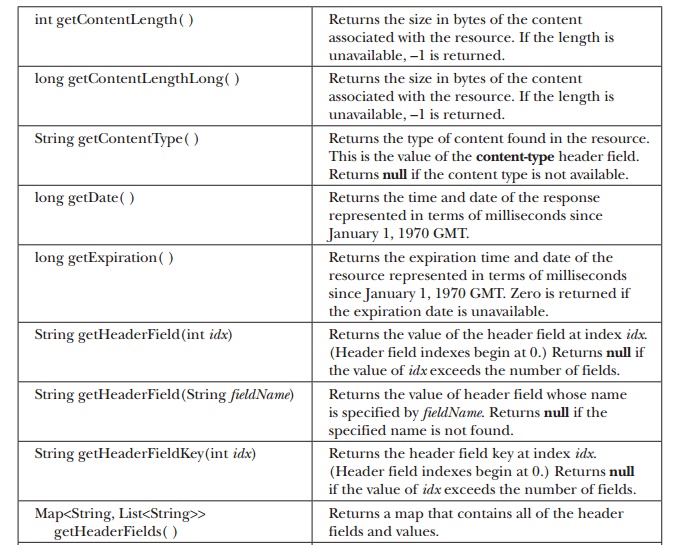Chapter: Java The Complete Reference : The Java Library : Networking
URLConnection - Java Networking
URLConnection
URLConnection is a general-purpose class
for accessing the attributes of a remote resource. Once you make a connection to a remote server, you can use URLConnection to inspect the properties
of the remote object before actually transporting it locally. These attributes
are exposed by the HTTP protocol specification and, as such, only make sense
for URL objects that are using the
HTTP protocol.
URLConnection defines several methods. Here
is a sampling:


Notice
that URLConnection defines several
methods that handle header information. A header consists of pairs of keys and
values represented as strings. By using getHeaderField(
), you can obtain the value associated with a header key. By calling getHeaderFields( ), you can obtain a
map that contains all of the headers. Several standard header fields are
available directly through methods such as getDate(
) and getContentType( ).
The
following example creates a URLConnection
using the openConnection( ) method
of a URL object and then uses it to
examine the document’s properties and content:
// Demonstrate URLConnection.
import java.net.*;
import java.io.*;
import java.util.Date;
class UCDemo
{
public static void
main(String args[]) throws Exception { int c;
URL hp = new
URL(http://www.internic.net"); URLConnection hpCon = hp.openConnection();
// get date
long d = hpCon.getDate();
if(d==0)
System.out.println("No
date information."); else
System.out.println("Date:
" + new Date(d));
// get content type
System.out.println("Content-Type:
" + hpCon.getContentType());
// get expiration date
d = hpCon.getExpiration();
if(d==0)
System.out.println("No
expiration information."); else
System.out.println("Expires:
" + new Date(d));
// get last-modified date
d = hpCon.getLastModified();
if(d==0)
System.out.println("No
last-modified information."); else
System.out.println("Last-Modified:
" + new Date(d));
// get content length
long len =
hpCon.getContentLengthLong(); if(len == -1)
System.out.println("Content
length unavailable."); else
System.out.println("Content-Length:
" + len);
if(len != 0) {
System.out.println("===
Content ===");
InputStream input =
hpCon.getInputStream(); while (((c = input.read()) != -1)) {
System.out.print((char) c);
}
input.close();
} else {
System.out.println("No
content available.");
}
}
}
The
program establishes an HTTP connection to www.internic.net over port 80. It then displays several header values and retrieves
the content. You might find it interesting to try this example, observing the
results, and then for comparison purposes try a different web site of your own
choosing.
Related Topics